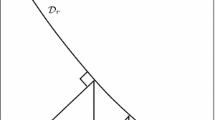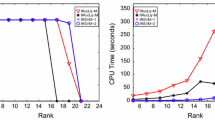Abstract
The affine rank minimization problem is to minimize the rank of a matrix under linear constraints. It has many applications in various areas such as statistics, control, system identification and machine learning. Unlike the literatures which use the nuclear norm or the general Schatten \(q~ (0<q<1)\) quasi-norm to approximate the rank of a matrix, in this paper we use the Schatten 1 / 2 quasi-norm approximation which is a better approximation than the nuclear norm but leads to a nonconvex, nonsmooth and non-Lipschitz optimization problem. It is important that we give a global necessary optimality condition for the \(S_{1/2}\) regularization problem by virtue of the special objective function. This is very different from the local optimality conditions usually used for the general \(S_q\) regularization problems. Explicitly, the global necessary optimality condition for the \(S_{1/2}\) regularization problem is a fixed point inclusion associated with the singular value half thresholding operator. Naturally, we propose a fixed point iterative scheme for the problem. We also provide the convergence analysis of this iteration. By discussing the location and setting of the optimal regularization parameter as well as using an approximate singular value decomposition procedure, we get a very efficient algorithm, half norm fixed point algorithm with an approximate SVD (HFPA algorithm), for the \(S_{1/2}\) regularization problem. Numerical experiments on randomly generated and real matrix completion problems are presented to demonstrate the effectiveness of the proposed algorithm.


Similar content being viewed by others
Notes
The SVT code is available at http://svt.caltech.edu.
The FPC code is available at http://svt.caltech.edu.
The FPCA code is available at http://www.columbia.edu/~sm2756/FPCA.htm.
The PD code is available at http://www.sfu.ca/~yza30/homepage/PD_Rank/PD_Rank.html.
References
Absil, P.-A., Baker, C., Gallivan, K.: Trust-region methods on Riemannian manifolds. Found. Comput. Math. 7, 303–330 (2007)
Bian, W., Chen, X.: Worst-case complexity of smoothing quadratic regularization methods for non-Lipschitzian optimization. SIAM J. Optim. 23, 1718–1741 (2013)
Boumal, N., Absil, P.: RTRMC: A riemannian trust-region method for low-rank matrix completion, In: NIPS (2011)
Cai, J., Candès, E., Shen, Z.: A singular value thresholding algorithm for matrix completion. SIAM J. Optim. 20, 1956–1982 (2010)
Candès, E., Plan, Y.: Matrix completion with noise. Proc IEEE 98, 925–936 (2010)
Candès, E., Recht, B.: Exact matrix completion via convex optimization. Found. Comput. Math. 9, 717–772 (2009)
Candès, E., Romberg, J., Tao, T.: Robust uncertainty principles: exact signal reconstruction from highly incomplete frequency information. IEEE Trans. Inf. Theory 52, 489–509 (2006)
Candès, E., Tao, T.: The power of convex relaxation: near-optimal matrix completion. IEEE Trans. Inf. Theory 56, 2053–2080 (2010)
Chartrand, R.: Exact reconstructions of sparse signals via nonconvex minimization. IEEE Signal Process. Lett. 14, 707–710 (2007)
Chartrand, R.: Nonconvex regularization for shape preservation. IEEE Int. Conf. Image Process. I, 293–296 (2007)
Chartrand, R.: Fast algorithms for nonconvex compressive sensing: MRI reconstruction from very few data. In: Proceedings of IEEE International Symposium on Biomedical Imaging, pp. 262–265 (2009)
Chartrand, R., Staneva, V.: Restricted isometry properties and nonconvex compressive sensing. Inverse Probl. 24, 20–35 (2008)
Chen, X., Ge, D., Wang, Z., Ye, Y.: Complexity of unconstrained \(\ell _2\)-\(\ell _p\) minimization. Math. Program. Ser. A 143, 371–383 (2014)
Chen, X., Xu, F., Ye, Y.: Lower bound theory of nonzero entries in solutions of \(\ell _2-\ell _p\) minimization. SIAM J. Sci. Comput. 32, 2832–2852 (2010)
Donoho, D.: Compressed sensing. IEEE Trans. Inf. Theory 52, 1289–1306 (2006)
Ding, C., Sun, D., Toh, K.-C.: An introduction to a class of matrix cone programming. Math. Program. Ser. A 144, 141–179 (2014)
Drineas, P., Kannan, R., Mahoney, M.W.: Fast Monte Carlo algorithms for matrices ii: computing low-rank approximations to a matrix. SIAM J. Comput. 36, 158–183 (2006)
Efron, B., Hastie, T., Johnstone, I.M., Tibshirani, R.: Least angle regression. Ann. Stat. 32, 407–499 (2004)
Fazel, M.: Matrix rank minimization with applications. PhD thesis, Stanford University, (2002)
Fazel, M., Hindi, H., Boyd, S.: A rank minimization heuristic with application to minimum order system approximation. In: Proceedings of American Control Conference (2001)
Fazel, M., Hindi, H. , Boyd, S.: Log-det heuristic for matrix rank minimization with applications to Hankel and Euclidean distance matrices. In: Proceedings of American Control Conference (2003)
Hale, E.T., Yin, W., Zhang, Y.: A fixed-point continuation method for \(\ell _1\)-regularized minimization: methodology and convergence. SIAM J. Optim. 19, 1107–1130 (2008)
Ji, S., Sze, K.-F., Zhou, Z., So, A., Ye, Y.: Beyond convex relaxation: a polynomial-time non-convex optimization approach to network localization. In: IEEE Conference on Computer Communications (INFOCOM), pp. 2499–2507 (2013)
Keshavan, R., Montanari, A., Oh, S.: Matrix completion from a few entries. IEEE Trans. Inf. Theory 56, 2980–2998 (2010)
Lai, M.-J., Xu, Y., Yin, W.: Improved iteratively rewighted least squares for unconstrained smoothed \(\ell _p\) minimization. SIAM J. Numer. Anal. 5, 927–957 (2013)
Lin, Z., Chen, M., Ma, Y.: The augmented Lagrange multiplier method for exact recovery of corrupted low-rank matrices, NIPS (2011)
Liu, Y., Sun, D., Toh, K.-C.: An implementable proximal point algorithmic framework for nuclear norm minimization. Math. Program. Ser. A 133, 399–436 (2012)
Liu, Z., Vandenberghe, L.: Interior-point method for nuclear norm approximation with application to system identification. SIAM J. Matrix Anal. Appl. 31, 1235–1256 (2009)
Lu, Z., Zhang, Y., Liu, X.: Penalty decomposition methods for rank minimization. Optim. Methods Softw. 30, 531–558 (2015)
Ma, S., Goldfarb, D., Chen, L.: Fixed point and Bregman iterative methods for matrix rank minimization. Math. Program. Ser. A 128, 321–353 (2011)
Mohan, K., Fazel, M.: Iterative reweighted algorithms for matrix rank minimization. J. Mach. Learn. Res. 13, 3253–3285 (2012)
Nie, F., Huang, H., Ding, C.: Low-rank matrix recovery via efficient Schatten \(p\)-norm minimization. In: Proceedings of the twenty-sixth AAAI conference on artificial intelligence, pp. 655–661 (2012)
Rakotomamonjy, A., Flamary, R., Gasso, G., Canu, S.: \(\ell _p\)-\(\ell _q\) penalty for sparse linear and sparse multiple kernel multitask learning. IEEE Trans. Neural Netw. 22, 1307–1320 (2011)
Rao, G., Peng, Y., Xu, Z.: Robust sparse and low-rank matrix decomposition based on the \(S_{1/2}\) modeling. Sci. China Inf. Sci. 43, 733–748 (2013)
Recht, B., Fazel, M., Parrilo, P.: Guaranteed minimum rank solutions of matrix equations via nuclear norm minimization. SIAM Rev. 52, 471–501 (2010)
Rockafellar, R.T.: Monotone operators and the proximal point algorithm. SIAM J. Control Optim. 14, 877–898 (1976)
Rohde, A., Tsybakov, A.: Estimation of high-dimensional low-rank matrices. Ann. Stat. 39, 887–930 (2011)
Skelton, R., Iwasaki, T., Grigoriadis, K.: A Unified Algebraic Approach to Linear Control Design. Taylor and Francis, Routledge (1998)
Sun, D.: Matrix Conic Programming. Dalian University of Science and Technology, Dalian (2011)
Tao, M., Yuan, X.: Recovering low-rank and sparse components of matrices from incomlete and noisy observations. SIAM J. Optim. 21, 57–81 (2011)
Toh, K.-C., Yun, S.: An accelerated proximal gradient algorithm for nuclear norm regularized least squares problems. Pac. J. Optim. 6, 615–640 (2010)
Tütüncü, R., Toh, K., Todd, M.: Solving semidefinite-quadratic-linear programs using SDPT3. Math. Program. Ser. B 95, 189–217 (2003)
Wen, Z., Yin, W., Zhang, Y.: Solving a low-rank factorization model for matrix completion by a nonlinear successive over-relaxation algorithm. Math. Program. Comput. 4, 333–361 (2012)
Xu, Z.: Data modeling: visual psychology approach and \(\ell _{1/2}\) regularization theory. Proc. Int. Congr. Math. 4, 3151–3184 (2010)
Xu, Z., Chang, X., Xu, F., Zhang, H.: \(\ell _{1/2}\) regularization: a thresholding representation theory and a fast solver. IEEE Trans. Neural Netw. Learn. Syst. 23, 1013–1027 (2012)
Xu, Z., Guo, H., Wang, Y., Zhang, H.: Representation of \(\ell _{1/2}\) regularizer among \(\ell _q (0 < q \le 1)\) regularizer: an experimental study based on phase diagram. Acta Autom. Sin. 38, 1225–1228 (2012)
Acknowledgements
The authors are thankful to the two anonymous referees for their valuable suggestions and comments that help us revise the paper into the present form. The authors are also grateful to Prof. Shiqian Ma at The Chinese University of Hong Kong for sharing the FPCA code.
Author information
Authors and Affiliations
Corresponding author
Additional information
Dingtao Peng was supported by the National Natural Science Foundation of China (Grant No. 11401124) and the Scientific Research Projects for the Introduced Talents of Guizhou University (Grant No. 201343). Naihua Xiu was supported by the Key Program of National Natural Science Foundation of China (Grant No. 11431002) the National Natural Science Foundation of China (Grant No. 71271021).
Rights and permissions
About this article
Cite this article
Peng, D., Xiu, N. & Yu, J. \(S_{1/2}\) regularization methods and fixed point algorithms for affine rank minimization problems. Comput Optim Appl 67, 543–569 (2017). https://doi.org/10.1007/s10589-017-9898-5
Received:
Published:
Issue Date:
DOI: https://doi.org/10.1007/s10589-017-9898-5
Keywords
- Affine rank minimization problem
- Matrix completion problem
- \(S_{1/2}\) Regularization problem
- Fixed point algorithm
- Singular value half thresholding operator




